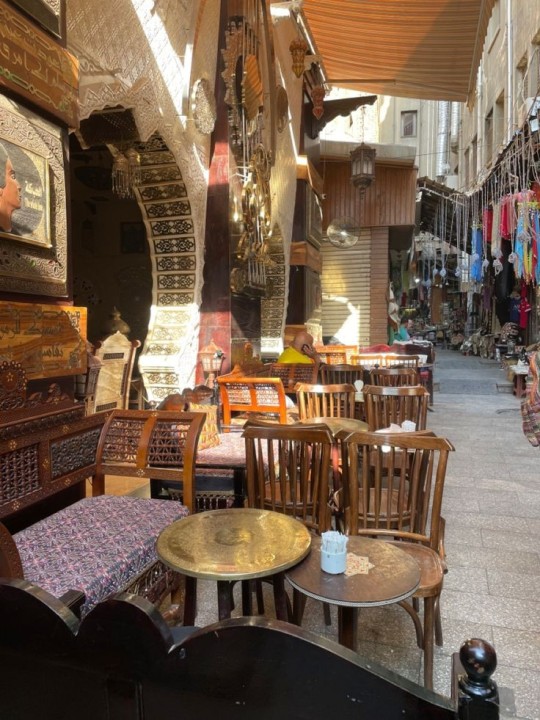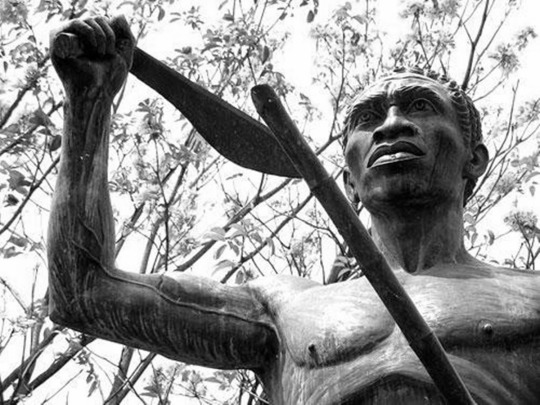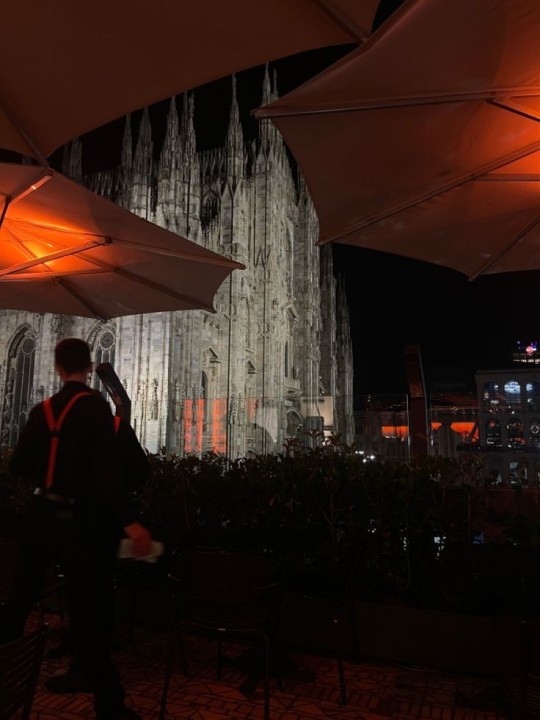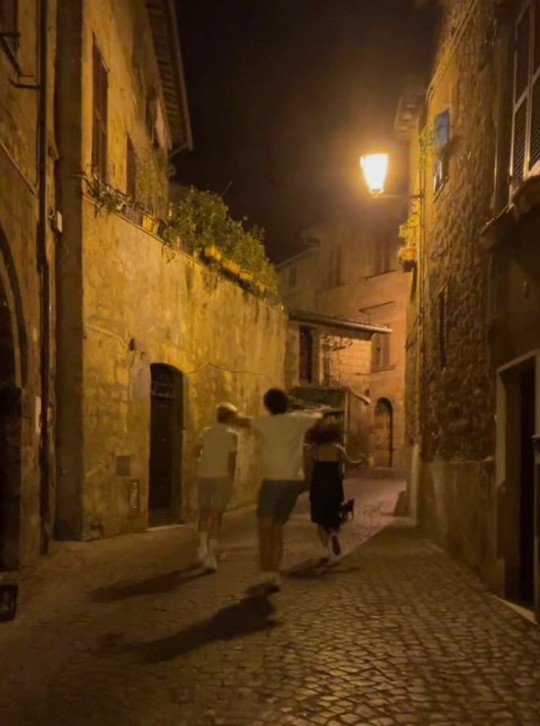#AFRICA OCCIDENTAL
Explore tagged Tumblr posts
Text
XPLORALYA: TOUR SITES AND HISTORICAL MONUMENTS IN GHANA "MANHYIA PALACE"
SITIOS TURÍSTICOS Y MONUMENTOS HISTÓRICOS EN GHANA “PALACIO MANHYIA” Suleiman Abdallah Business Administration, Turismo & Viajes, Actor, Writer. Director Gral. GHANA La Agencia Mundial de Prensa – Prensa Especializada The Manhyia Palace Museum was created within the old residence of Otumfuo Agyeman Prempeh I and Otumfuo Sir Osei Agyeman Prempeh II, the thirteenth and fourteenth Kings of Asante…

View On WordPress
#AFRICA#AFRICA OCCIDENTAL#ANTIGUA RESIDENCIA#ASANTEHENE AGYEMAN PREMPEH I#EDIFICIO HISTORICO#GHANA#GHANA. THE WORLD PRESS AGENCY#lomasleido#MANHYIA PALACE#OTUMFUO OPOKU WARE II#SULEIMAN ABDALLA#TOUR SITES & HISTORICAL MONUMENTS#TURISMO#XPLORALYA
0 notes
Text




#aesthetic#arabic#arabic girl#sahara occidental#western#west africa#africa#brazil#brasil#lana del ray aesthetic#coquette#gold jewelry#culture#spencer reid#dark academia#jungkook#criminal minds#love#coquette aesthetic#fluff#lana del rey#doctor spencer reid#Spotify
13 notes
·
View notes
Text
Asia, Africa e America Latina investono in scuola e tecnologia, mentre l’Occidente si perde in battaglie simboliche. Chi guiderà davvero il mondo? Scopri di più su Alessandria today.
#Africa sviluppo#Alessandria today#America Latina innovazione#Asia crescita#battaglie simboliche#censura e cultura#Cina#confronto globale#Controcampo#crisi Europa#cultura e società#declino Occidente#dibattito ideologico#disuguaglianza globale#educazione e sviluppo#Europa e ideologia#futuro globale#globalizzazione asimmetrica#Google News#identità e linguaggio#inclusività#India#innovazione educativa#investimenti esteri#italianewsmedia.com#Kenya#Lava#leadership mondiale#Memoria storica#nuova economia
0 notes
Text
Reading al Mandela
Venerdì 20 settembre 2024 – ore 20 Ristorante Mandela, corso Garibaldi 16 Perugia Italia Europa Occidente Pianeta Terra Reading poetico a cura dell’associazione culturale ARRIVO APS, a cura di Nicola Castellini in collaborazione con Taifour nell’ambito del Progetto Fiorivano le viole & friends finanziato dalla Regione Umbria con risorse statali del Ministero del lavoro e delle Politiche…

View On WordPress
#africa#arrivo aps#associazione culturale arrivo#Corso garibaldi#Fiorivano le viole#Nicola Castellini#occidente#poesia#Reading#ristorante mandela
0 notes
Text
CAREZZA DEL VENTO
14 / 09 / 2.000 Raggiungere il suo studio ogni settimana diventerà per me un rito estremamente gradevole, nonostante la ripetitività; mi piace pensare che di giovedì in giovedì alle ore otto e venti attraverserò il ponte delle Guglie, arriverò alla stazione santa Lucia, mi fermerò all’edicola di Nane per prendere “La nuova Venezia”, acquisterò il biglietto, l’oblitererò, prenderò il treno delle…

View On WordPress
0 notes
Text
In Occidente Bank, oliveta proelii facta sunt. Per tempus autem olea, quae quotannis inter Octobrem et Novembrem fit, impetus Israeli coloni contra agricolas Palaestinos frequentiores et intensiores fiunt. Anno 2021 fuerunt saltem 42, hoc anno, in duabus primis septimanis, UN documentis 22, in quibus saltem 800 oleae deperditae sunt. Quidam ex his sic fuit in villa Burin, 80% quarum zona C cadit sub potestate administrativi et militares et amni Yitzhar et Har Bracha sita est: duae mansiones i quorum incolae saevitiam suam innotuerunt. Per impetum in mense of Novembris, puer rusticus de Burino, lapide ictus colonus iactus est oculus unus. Palaestinae operarius oleum olivae recenter pressum in vas, deinde to
molendinum oleum lapideum in Palaestinae vico Bizarya prope the Urbs Occidentalis Bank Nabli, die 6 Novembris 2022. EPA/ALAA BADARNEH Pro 2.500 incolae pagi inter meridiem et meridiem Nabli in Occidentali Bank septentrionali, the ex olivibus maxime reditibus; ut sunt saltem 100,000 familiae Palaestinae, iuxta IR. Sed in hac villa,
cotidiana opera agriculturae periculum movet. In terra arabili sita in zona C, vetitum est sine speciali permissu obtentae agriculturae actiones exercere Ab Israele Civilis Administrationis, Israelis gubernatio in Occidente Bank edita est. Et etiam cum rustici procurant illud accipere et ad agros vadant, pauci haben diebus complere collectio.
Palaestinae agricolae foliis ut eruat olivis ; sita in extrema parte ripae occidentalis pagi Asera, prope urbem Nablum, 11
Novembris 2022. EPA/ALAA BADARNEH Impugnationes colonorum pressius in his gradibus contractae sunt et intendunt deterrere Palaestinorum accessus ad agros eorum est ut tunc ibi imperium civitatis enuntien. Israel. In facto, secundum legem terre Israelis hereditariam ab aetate Ottomanica, a ager incultus ultra triennium fit de jure proprietatis judaici. Not pauci sunt agrestes qui, verisimilitudine pugnandi sentientes, deserueruntad agros in zona C. Colonus violentia non solum impedit messis vincere. Ratam approbatio permissionum est revera in declinationibus acutis, eundo ab 71% in 2014 ad 27% in 2020 . Declinatio in numero permittit agricolas Palaestinos non permittit suas actiones exsequi agriculturae necessariae sunt ad curam terrarum et arborum per annum difficultas, quae fructuositas agrorum multum minuit et consequenter eorum afficit reditus qui minora omni anno. Palaestinae agricolae ientaculum habent in oliveto suo, in extrema parte ecclesiae Villa Occidentalis Bank Asera, prope urbem Nablum, die 11 Novembris 2022. EPA/ALAA
badarneh Messis olea non solum est vectigal, sed significat praesertim tempus quo familiae simul conveniunt ac suum vinculum cum Ecclesia celebrant terra, saepe ramis centenariis arboribus percutiendo, prioribus generationibus consita. Re quidem vera, in cultura Palaestinae, olea arbor symbolum est longaevitatis et resistentiae. Sed iuxta sedes Israelis, vita harum arborum periculum est. Secundum crucem rubra, inter 2020 et 2021 saltem 9, 300 olivae in Territoriis Palaestinae exstirpatae sunt; figura, quae ad 800,000 surgit, si tempore repetuntur, usque ad annum 1967 bellum sex dies, quorum finis Israel magnas partes vicit quae nunc est Argentaria occidentalis Sinai Peninsula, Orientalis Hierosolyma et Arces Golanae. Renovatio oppugnationum a maximis fimbriis incolarum illegalium Israeli secundum ius gentium, comitiis die 1 mensis Novembris factum est anno proximo, partes ius religionis extremae sequitur (Zionist Party Religiosus et Otzma Yehudit) 6 sedes obtinuerunt ex 120, quotquot satis fuerunt tractatus de formatione crucialorum in regimine.
Dr De Beer
0 notes
Text
El Ministro de Minas e Hidrocarburos de Guinea Ecuatorial se une a la Semana Africana de la Energía (AEW) 2023 como orador principal
El Ministro de Minas e Hidrocarburos de Guinea Ecuatorial se une a la Semana Africana de la Energía (AEW) 2023 como orador principal
La Cámara Africana de Energía (AEC) (www.EnergyChamber.org) se complace en anunciar que Antonio Oburu Ondo, Ministro de Minas e Hidrocarburos de Guinea Ecuatorial, participará como orador principal en la conferencia African Energy Week (AEW) 2023 (www.AECWeek.com), que tendrá lugar del 16-20 de Octubre en Ciudad del Cabo (Sudafrica). Durante el evento, El Ministro Ondo brindará información sobre…

View On WordPress
#AEC#AEW#África#África Occidental#Africa Oil Corporation#African Energy Chamber#African Energy Week#Antonio Oburu Ondo#Cámara Africana de Energía#EnergyChamber#GEPetrol#MEG#Ministerio de Minas e Hidrocarburos#Networking#NJ Ayuk#Panoro Energy#Petróleo y Gas#Punta Europa#Reservas#Sistema de Oleoductos de África Central#Sudafrica
0 notes
Text

Known as the Primer Libertador de America or “first liberator of the Americas,” Gaspar Yanga led one of colonial Mexico’s first successful slave uprisings and would go on to establish one of the Americas earliest free black settlements.
Rumored to be of royal lineage from West Africa, Yanga was an enslaved worker in the sugarcane plantations of Veracruz, Mexico. In 1570 he, along with a group of followers, escaped, fled to the mountainous regions near Córdoba, and established a settlement of former slaves or palenque. They remained there virtually unmolested by Spanish authorities for nearly 40 years. Taking the role of spiritual and military leader, he structured the agricultural community in an ordered capacity, allowing its growth and occupation of various locations.
During that time, Yanga and his band, also known as cimarrónes, were implicated in the disruption and looting of trade goods along the Camino Real (Royal Road) between Veracruz and Mexico City. They were also held responsible for attacking nearby haciendas and kidnapping indigenous women. Perceived as dangerous to the colonial system of slavery through their daring actions against royal commerce and authority, New Spain’s viceroy called for the annihilation of Yanga’s palenque. Destroying the community and its leader would send a message to other would-be rebellious slaves that Spain’s authority over them was absolute.
In 1609, Spanish authorities sent a well-armed militia to defeat Yanga and his palenque but were defeated. Yanga’s surprise victory over the Spanish heightened the confidence of his warriors and the frustration in Mexico City.
After defeating other Spanish forces sent again the palenque, Yanga offered to make peace but with eleven conditions, the most important being recognition of the freedom of all of the palenque’s residents prior to 1608, acknowledgment of the settlement as a legal entity which Yanga and his descendants would govern, and the prohibition of any Spanish in the community. Yanga, in turn, promised to serve and pay tribute to the Spanish crown. After years of negotiations, in 1618, the town of San Lorenzo de Los Negros was officially recognized by Spanish authorities as a free black settlement. It would later be referred to as Yanga, named after its founder.
•••
Conocido como el primer libertador de las Americas, Gaspar Yanga lideró exitosamente una de las primeras revueltas de esclavos en el México colonial y estableció una de las primeras ciudades negras y libres de América.
Se rumoreaba que era del linaje real de África Occidental. Yanga fue un esclavo que trabajó en las plantaciones de caña de azúcar de Veracruz, México. En 1570, él junto con un grupo de sus partidarios, se escaparon y huyeron hacia las montañas ubicadas en las regiones cercanas a Córdoba y estableció la primer ciudad o asentamiento para antiguos esclavos, también llamado palenque. Prácticamente permanecieron ahí por casi cuarenta años, sin ser molestados por las autoridades Españolas. Tomando el rol de guía espiritual y militar, él organizó la comunidad agrícola con una capacidad ordenada, así permitiendo el crecimiento y ocupación de varias ubicaciones.
Durante este tiempo, Yanga y su banda, también conocidos como cimarrones, estuvieron implicados en la interrupción y saqueo de bienes comerciales a lo largo del Camino Real entre Veracruz y Ciudad de México. También se les responsabilizó por los ataques a las haciendas cercanas y de secuestrar a mujeres indígenas. Percibido como un peligro para el sistema colonial de la esclavitud, sus audaces acciones contra el comercio y la autoridad real hicieron que el virrey de Nueva España pidiera la aniquilación del palenque de Yanga. El destruir a la comunidad y a su líder enviaría un mensaje a otros posibles esclavos rebeldes de que la autoridad de España sobre ellos era absoluta.
En 1609, las autoridades españolas enviaron una milicia fuertemente armada para derrotar a Yanga y su palenque, pero fueron derrotadas. La sorpresiva victoria de Yanga sobre los españoles aumentó la confianza de sus guerreros y la frustración en la Ciudad de México.
Después de derrotar a otras fuerzas españolas enviadas nuevamente al palenque, Yanga se ofreció a hacer las paces pero con once condiciones, siendo la más importante el reconocimiento de la libertad de todos los que residían en el palenque desde antes de 1608, el reconocimiento del asentamiento como entidad legal que sería gobernado por Yanga y sus descendientes, y la prohibición de cualquier español en la comunidad. Yanga, a su vez, se comprometió a servir y rendir homenaje a la corona española. Después de años de negociaciones, en 1618, el pueblo de San Lorenzo de Los Negros fue reconocido oficialmente por las autoridades españolas como un asentamiento negro y libre. Más tarde se la conocería como Yanga, en honor a su fundador.
#mexico#blackhistory#history#mexican#black history is everybody's history#historia africana#historyfacts#heritage#black history is world history#black history is american history#africanhistory365#africanhistory#africanheritage#blacklivesalwaysmatter#blacklivesmatter#blackhistorymonth#blackpeoplematter#mexican history#knowyourhistory#african history#black history#black history month#historia#culture#blackhistoryyear#blackownedandoperated#freedom fighters#freedom#knowledgeispower#knowledgeisfree
72 notes
·
View notes
Text
I was asked for ressources on Western Sahara so here is a list.
Context: Western Sahara was colonized by Spain. In 1975 Spain was about to leave and they somehow decided that it was their right to fucking give the land despite the fact that the people did not want it. So Spain kinda agreed to give the land to Morocco (2/3) and Mauritania (1/3). Except they had no right to. Morocco then organized the “Green March” a march during which Moroccan colonizers marched to Western Sahara and settled there. Becoming settlers in a land that did not belong to them. Morocco claims that Western Sahara belongs to them because once a long time ago (in like 1040) the chiefs of multiple Sahrawi tribes allegedly swore allegiance to the Sultan of Morocco. It makes no freaking sense. On top of it the founder of the dynasty to which Western Sahara allegedly swore allegiance was an Amazigh man from Mauritania not from Morocco. Anyway after Morocco colonized Western Sahara in 1975, a war broke. In 1979, Mauritania gave back the land Spain had given them but Morocco still refused to give back their land to the Sahrawi people. They actually decided that if Mauritania didn’t want that piece of Western Sahara then it would also belong to Morocco and they colonized it too. In 1991 a ceasefire was signed under the condition that a vote would be organized for the independence of Western Sahara. Except they never voted… Morocco refuses to. In 2020, the Polisario (the name of the Sahrawi resistance) blocked a bunch of trucks between the border of Western Sahara and Mauritania. Morocco considered that it was a declaration of war and the ceasefire ended.
(If people wanna know how Algeria is involved in all this just tell me I’ll make a post)
Now the ressources to learn more about what’s happening!!
Sons of the clouds, the last (colony of Africa) a documentary in Spanish and Hassania (Sahrawi language) about Western Sahara. The link included subtitles in French.
An article from Amnesty international regarding how a Sahrawia activist, Sultana Khaya, was abused by Moroccans authorities.
The book “Sáhara occidental: un viaje a la libertad” by Taleb Alisalem a sahrawi activist. Only available in Spanish but if you have Twitter you should really really follow him. He shares a lot of information past and current on the subject with sources.
A human rights watch article from 2022 about the situation in Western Sahara (the article mention the Human rights situation in Morocco too)
Because listening to local journalists is very very important here is a Sahrawi newspaper in multiple languages: in Arabic in English in French and in Spanish
The APS (Algeria Press Service) is also a good ressource BUT I wouldn’t suggest to quote it when you’re debating with someone who is pro colonialism. Algeria is 100% pro Western Sahara so people against the independence of Western Sahara don’t consider that Algeria is a reliable source on the subject.
A friend suggested the Book “Sahara occidental: conflit oublié, population en mouvement” by Sébastien Boulay (Western Sahara: forgotten conflit, displaced population) to my knowledge its only available in French maybe in Spanish too as the co-author is Spanish. I personally haven’t read this one yet but I 100% trust the person who recommended me the book.
524 notes
·
View notes
Text
Who gets to be human? On Black geographies, damned people living in inhospitable places, other ways of knowing and being, and racist legacy of European academic epistemologies.
---
---
The idea of the plantation is migratory. [...] Past colonial encounters created material and imaginative geographies that reified global segregations through “damning” the spaces long occupied by Man's human others. Here, damning can be understood in two interlocking ways: as a fencing in and as a condemnation of racial-sexual difference. The uninhabitable - in particular, the landmasses occupied by those who, in the fifteenth and sixteenth centuries, were unimaginable, both spatially and corporeally - is the geographic (non)location through which the plantation emerged. From Caliban's “uninhabited” island in Shakespeare's The Tempest, to the regions within Africa identified as too hot to be livable, the landmasses deemed uninhabitable presented a geographic predicament upon “discovery.” [...] [A] "new symbolic construct of race," which coincided with post-1492 colonial arrangements, organized much of the world according to a racial logic. [...] The colonial enactment of geographic knowledge mapped “a normal way of life” through measuring different degrees of humanness and attaching different versions of the human to different places. […] [I]n the sites of toxicity, environmental decay, pollution […] inhabited by impoverished communities […] the [current] geographies of the racial other are emptied out of life precisely because the historical constitution of these geographies has cast them as lands of no one. So in our present moment, some live in the unlivable, and to live in the unlivable condemns the geographies of marginalized to death over and over again. Life, then, is extracted from particular regions […]. If we believe that the city [the prison, the resort, other "postcolonial spaces"] is the commercial expression of the plantation and its marginalized masses, and that the plantation is a persistent but ugly blueprint of our contemporary spatial troubles, Wynter's essay asks that we seek out secretive histories […]. [R]acial violence haunts, [...] the struggles we face, intellectually, are a continuation of plantation narratives that dichotimize geographies into us/them and hide secretive histories that undo the teleological [...] underpinnings of [colonial, imperial, modern] spatiality.
Text by: Katherine McKittrick. “Plantation Futures.” Small Axe, Volume 17, Number 3, November 2013 (No. 42), pages 1-15. [Emphasis mine.]
---
---
Registering the marine world as central to the making of modernity - from slave ships and sea-borne empires to container logistics and the industrialized extraction of its resources (from fish to fossil fuels) - we encounter the constant of colonialism in the haunting racism that produces the violent grammar of inhospitality, today etched on the body of the contemporary migrant. [...] This is to interrupt and rework Occidental historiography, sociology, and philosophy, and to puncture their faith in rendering the world transparent to their will. […] Promoting the instability of critical language is to take responsibility for what Achille Mbembe calls the becoming-black of the world: where the production of subjection provokes alternative knowledge, practices, and politics […]. Today the increasing use of drones in the Mediterranean as part of the technology of governance marks the latest abandonment of social responsibility to the bio-surveillance of unwanted bodies and discarded lives. Smart borders take migrants far below the category of “bare life,” [...] and extends the racial profiling written into the historical premises that betray their deep incubation in the refusal to register the languages and limits of the white myths [...]. From the Black Atlantic to the Black Mediterranean: seas of dispossession and unbelonging have constantly demonstrated the political, juridical, and onto-epistemological limits of modernity. They promote a constant critique of the epistemic foundations of Western [colonial "liberalism"]. Those on the water, the wretched of the sea, the damned [...], who cannot source their identity in the territory of the nation-state, are without rights. They have no social [...] validity. [...] Yet they simultaneously [...] exist, persist, and resist. [...] The algorithm sputters in the dark while cut-up, bricolage, collage, and montage work the critical gaps [...]. The archives unwind to expose other computations of time and further folds in space: the promise of foreign cartographies [...].
Text by: Iain Chambers. A section by Chambers in the essay co-authored by Tiziana Terranova and Iain Chambers. “Technology, Postcoloniality, and the Mediterranean.” e-flux Journal Issue #123. December 2021. [Emphasis mine.]
---
---
[T]he framing of the inhumanities forces a reckoning with the humanist liberal subject that orders the humanities: an invisible and indivisible white subject position [...]. In Césaire’s (2000 [1972]) Discourse on Colonialism, he suggested that “at the very time when it most often mouths the word, the West has never been further from being able to live a true humanism [...]”. In another searing critique of [White, European, liberal/colonial] humanism, Fanon (1961) tied the unrealized figure of a true humanism to the earth, as a wretched counterpoint, whereby the inhuman residues of the colonial project abide as discarded matter […]. Those blackened colonial afterlives in “modernity’s project of unfreedom” (Walcott 2014, 94) are still very much present in the political geologies of climate change vulnerabilities, the wasting effects of racial capitalism, and neo-extractivist economies […]. The narrative arc of humanism, Scott (2000) suggested in conversation with Wynter, is often told as a kind of European coming-of-age story. […] The Anthropocene discourse follows the same coming-of-age humanist script [...]. Sylvia Wynter, W.E.B. DuBois, and Achille Mbembe all showed how that genealogy of man [as universal concept] was underscored by the racial division of life and nonlife. […] In its simplest iteration, there are forms of life on one side and nonlife on the other; nonlife that is constituted through death, and more recently in Mbembe and Povinelli’s writing through forms of social death, exhaustion, and extinguishment, wherein nonlife emerges as a zone of governance. The gravitational pull that centers these divisions between life and nonlife is the human subject as it is conceived through a Western normative frame [...]. As new forms of racialized beings were articulated through sixteenth- through nineteenth-century paleontology in the context of colonialism, geology was also articulating new origins of the earth, as well as forming the material praxis of their rearrangement (through mining, ecological rearrangements and extractions, and forms of geologic displacements such as plantations, dams, fertilizers, crops, and introduction of “alien” animals). [...] Historically, this normative sphere of humanism was racist and specifically antiblack, and without challenging that history, it remains so, every time the universal or human is invoked. Some of the greatest challenges, of course, came from anticolonial thinkers struggling to make sense of their painful histories in their fullest terms, such as Fanon (1959, 1961), Césaire, Glissant, C. L. R. James and Wynter. As Wynter (2000) commented, “The degradation of concrete humans, that was/is the price of empire, of the kind of humanism that underlies it” (154). For Wynter (2000), “what is called the West [...] begins with the founding of post-1492 Caribbean” (152). Wynter challenged the geographical imaginary that the Americas and Caribbean are somehow an epistemological outside to Western knowledge […].
Text by: Kathryn Yusoff. “The Inhumanities.” Annals of the American Association of Geographers, Volume 11, Issue 3. November 2020. [Emphasis mine.]
---
---
But what becomes of the native-occupied “uninhabitable” zones is a geo-racial reorganization. The “new symbolic construct of race,” which coincided with post-1492 colonial arrangements, was spatially organized according to a new […] logic. […] That is, the uninhabitable […] is underscored by racial and sexual differences. To transform the [land] […], and make this transformation profitable, the land must become a site of racial-sexual regulation, a geography that maps “a normal way of life” […] This is expressed through uneven geographies: spatial arrangements [...]. The inhabitability [...] also produces [...] forms of geographic nonexistence, which differ from what was assumed was "not there." [...] [W]hat Edouard Glissant describes as the "real but long unnoticed" places [...]: cultural sharings, new poetics, new ways of being [...]. Those who occupy the spaces of Otherness are always already encountering space and therefore articulate how genres or modes of humanness are intimately connected to where we/they are ontologically as well as geographically. To return to an earlier discussion, spaces of Otherness are “palpitating with life.” [...]
Text by: Katherine McKittrick. “Demonic Grounds: Sylvia Wynter.” Demonic Grounds: Black Women and The Cartographies of Struggle. 2006. [Emphasis mine.]
#sorry doing this in breakroom at work#tidalectics#black methodologies#really want to also place next to this my summaries of an laura stolers writing on imperialist nostalgia and academic anthropology#as sometimes functioning basically imperial intellectual tourism or entertainment but stuck at work and cant find and edit them#ecologies#multispecies#katherine mckittrick#abolition#kathryn yusoff#geographic imaginaries#indigenous pedagogies#fred moten#pleistocene#my writing i guess#last tag about my writing only there for organizing purposes not to lay claim to their scholarship
47 notes
·
View notes
Text
EDITORIAL: Sahel, adiós a París
EDITORIALE: Sahel, Paris adieu Fabrizio Casari “Altrenotizie” Periodista – Editorialista Internacional Il Sahel agita l’Occidente. In particolare la Francia che, cacciata dal Mali, perde ora anche il Niger, pedina fondamentale nella sua scacchiera africana. L’uranio del Niger che viene a mancare è oggi a maggior ragione strategico dopo la fine dell’import di idrocarburi dalla Russia,…

View On WordPress
#ADIOS PARÍS#ALTRENOTIZIE#EDITORIAL#EDITORIALE#EL COLONIALISMO CAMBIA LA PIEL#EL VIENTO QUE SOPLA#FABRIZIO CASARI#FRANCIA#INTERESES FRANCESES#ITALIA#lomasleido#MALI#MUNDO#NIGER#NIGER Y SU 40% DE URANIO#NO SOLO FRANCIA SAQUEA AFRICA#RUPTURA EUROPA MOSCU#SAHEL#SAHEL AGITA OCCIDENTE#SAHEL UNA PANTALLA MAS QUE SE PROYECTA AL CAMBIO#URANIO
0 notes
Text
With white actors, their stereotypes are clear satire, while their authentic portrayals of accents are taken seriously—African accents are not afforded that luxury. Part of the authenticity and grit we’ve come to love in Good Will Hunting (1997) owes to the fact that both Matt Damon and Ben Affleck speak in accents native to South Boston—which successfully shows the importance of class distinctions, Will’s intellectual ability despite his “rough” surroundings, and rooting him in his neighborhood and background even as he progresses to new places and opportunities. Part of the joy of watching Mary Poppins (1964), is the grating sound of Dick Van Dyke’s bizarre “Cockney” accent. Often noted as one of the worst accents in film history, Van Dyke’s character sounded like he came from New Jersey, Australia, but Poppins is a children’s comfort film filled with magic, so audiences are already prepared to suspend their disbelief. Language, voice, and tone are vital parts of storytelling, but somehow caricature-like portrayals of African accents still manage to win Oscars, while Dick Van Dyke’s “Cockney” failure is an actor’s cautionary tale. This speaks to a larger issue: the hierarchy of occidental languages over languages from the global south, the (lack of) knowledge of African dialects, and a general laziness toward the research required to thoughtfully and effectively learn regional African accents. Alongside my research for this article, I also spoke to Djeneba Bagayoko, a linguist who specializes in African languages and is currently working on a book exploring the similarities in Ebonics and continental languages. When we discussed Beasts of No Nation—no nation indeed, as the film is set in an “unspecified” West African country—Djeneba pointed out the prevalence of guttural sounds and line delivery in a lower vocal pitch. While having a lower-pitched voice is completely within the rights of directors and actors to be a stylistic choice for a character, its unfortunate prevalence goes beyond artistic prerogative and seems closer to laziness or ignorance. Viola Davis’s accent in The Woman King is also delivered in a lower register, with an emphasis on guttural sounds and a sprinkling of that American English rhotic R that would not be present in a West African accent during the 1820s. Winston Duke’s accent in Black Panther (2018) also features guttural sounds, a low pitch, and even Nigerian facets of speech (adding “o” as a standalone sound at the end of sentences), despite the fact that the fictional nation of Wakanda is supposedly located in southeast Africa. Bagayoko rightly asked, “Why, when it comes to Africa, are we all lumped together?” Reducing Western and Southern African accents down to hard, low-pitched noises positioned at the back of the throat perpetuates the idea that African languages are too “other” for any attention to detail. The frequency with which we see this technique reiterates the view of Africans as homogenized and underdeveloped—a colonial perspective.
120 notes
·
View notes
Text








#gold#aesthetic#brazil#rome#black love#paris#french coquette#coquette aesthetic#coquette#love#cute#sahara occidental#arabic#africa#west africa#interracial couple#couple#spencer reid#lana del rey#criminal minds#dark academia#jungkook#fluff#le code#french song#Spotify
2 notes
·
View notes
Text

SPA:
Los Akan, una etnia del sur de Ghana, Costa de Marfil, parte de Togo y Libera, tejen cintas de tela en pequeños telares horizontales con poleas a los que colocan figuras que pueden representar antepasados o divinidades protectoras.
De ahí surge el tejido Kente característico de África occidental compuesto por franjas de colores de seda y algodón y que en su origen estaba reservado a la realeza Akan por su carácter sagrado.
Antes solo los hombres podían usar este tipo de telar pero desde hace un tiempo también se les permite a las mujeres.
ENG:
The Akan, an ethnic group from southern Ghana, Ivory Coast, part of Togo and Libera, weave cloth ribbons on small horizontal looms with pulleys to which they attach figures that may represent ancestors or protective divinities.
From there arises the Kente fabric characteristic of West Africa, composed of colorful stripes of silk and cotton, which was originally reserved for Akan royalty due to its sacred nature.
Previously only men could use this type of loom but for some time now women have also been allowed to use it.
91 notes
·
View notes
Text
Salto nel 2025
Trump ha vinto.
La lavanderia ucraina viene dissolta dall'interno per evaporazione dei fondi e sparizione dei mandanti. La pace con la Russia si firma in una settimana, sulla base dello status quo territoriale. Nel tempo i rapporti economici tra Russia e Occidente (Uk escluso) si rasserenano.
Prima condizione posta alla Russia per la pace, isolare l'Iran. Strozzato, questo cessa di supportare hamas e hezbollah: Gaza e il Sud Libano vengono bonificati, con grande gaudio silente tra gli arabi locali e limitrofi per il costoso lavoro sporco compiuto dagli israeliani.
SI INTENSIFICA LA CONFRONTATION CON LA CINA, che cerca sponde (non in Asia dove sanno bene che merda sia, ma) in Africa, Sudamerica e riprende a cercarle in Europa.
Essendo Confrontation non ancora militare, la scelta tra Oriente cinese e Occidente si attua sulla base delle scelte relative alla TRANSIZIONE ENERGETICA: chi non (la) salta un cinese è, è.
Non sarà mai un mondo ideale, solo un po' più chiaro.
21 notes
·
View notes
Text
The international reach of European football in particular is extending into homes around the world, appearing to retrace the pathways of the colonial project; in former colonies, it is nearly exclusively European football league matches, both live and replayed, that are broadcast. As Thomas McPhail writes in Electronic Colonialism: The Future of International Broadcasting and Communication (1981), electronic colonialism is the contemporary incarnation of military and mercantile colonialism, privileging western dominance and control of global information flows by international telecommunications cartels from the global north. The aftermath is three‑pronged: the wholesale commercialisation of the mass media (press, radio and television, including the film industries); one‑way rather than reciprocal flows of information from the global north to ‘dependent’ global‑south regions; and a high content of occidental history, norms and traditions with consequences for cultural domination. Football globalisation conforms to the core‑periphery logic, and its inner workings cascade along the global north–global south axis. International migration of football players from minor leagues in ‘peripheral’ regions of Africa, Asia and South America to major leagues in the ‘core’ region of Europe has elevated star players of diverse nationalities to the global stage. The players’ resultant celebrity status generates local fan bases of mostly young people in the players’ home countries, while boosting the global image and popularity of their European clubs. This rationale contributes to the football industry’s wide‑ranging value chain; a 2022 Rome Business School report presents football as the most profitable sport, with a global revenue of US$47 billion (£36.8 billion). Football’s value chain encompasses ticket sales, infrastructure development, sales of licensed products and endorsements, as well as transactional exchanges between governing bodies and federations, clubs and their shareholders, and numerous subsidiary businesses (football academies, satellite broadcasting corporations, sportswear industries, and football pools and betting companies).
17 notes
·
View notes